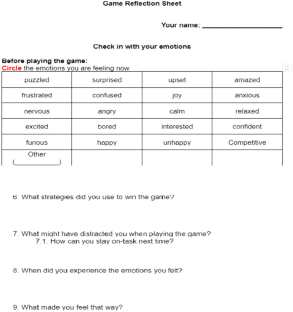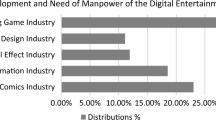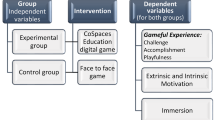Abstract
Secondary science students still struggle to master scientific concepts and apply content-based knowledge. The instructional design behind the incorporation of innovative technology and the use of game-based learning (GBL) could be a key to increasing student acquisition of science knowledge. Using a mixed methods design, this study examined the effects of a scaffolded Game-based Learning (GBL) science unit using a virtual reality (VR) game component. The VR game focused on the scientific method, lab safety, and equipment, and purposefully embedded instructional scaffolds to support the needs of diverse learners. The quasi-experimental study (pre- and post-test design) investigated the acquisition of targeted science knowledge with student groups of differing motivation levels and under two different game modes (immersive and non-immersive). With a mixed methods embedded design, quantitative data (student pre- and post-tests) was analyzed first followed by qualitative data (classroom video observations and student focus groups). Statistical analysis revealed: (1) students demonstrate an overall improvement on the post-test of targeted science knowledge in a scaffolded GBL learning design, (2) students using the immersive VR mode showed greater improvement in targeted science knowledge than students using the non-immersive desktop game, and (3) students with low intrinsic motivation performed better in the immersive VR than the desktop version. Further examination of qualitative data uncovered the GBL curricular activities and scaffolds may have also contributed to students’ science learning gains through reflection and discussion after gameplay experiences. The repeated multimodal learning opportunities and the opportunities to learn through whole-body movements were also found to be the potential reasons why the immersive VR group outperformed the non-immersive group.









Similar content being viewed by others
References
Al-Tarawneh, M. H. (2016). The effectiveness of educational games on scientific concepts acquisition in first grade students in science. Journal of Education and Practice, 7(3), 31–37.
Anderson, L. W., & Sosniak, L. A. (1994). Bloom’s taxonomy: A forty-year retrospective. Ninety-third Yearbook of the National Society for the Study of Education. The University of Chicago Press.
Aschbacher, P. R., Li, E., & Roth, E. J. (2010). Is science me? High school students’ identities, participation and aspirations in science, engineering, and medicine. Journal of Research in Science Teaching, 47(5), 564–582. https://doi.org/10.1002/tea.20353
Boller, S., & Kapp, K. (2017). Play to learn: Everything you need to know about designing effective learning games. ATD Press.
Braun, V., & Clarke, V. (2006). Using thematic analysis in psychology. Qualitative Research in Psychology, 3, 77–101. https://doi.org/10.1191/1478088706qp063oa
Brush, T. A., & Saye, J. W. (2002). A summary of research exploring hard and soft scaffolding for teachers and students using a multimedia supported learning environment. The Journal of Interactive Online Learning, 1(2), 1–12.
Chen, C.-H., & Law, V. (2015). Scaffolding individual and collaborative game-based learning in learning performance and intrinsic motivation. Computers in Human Behavior, 55, 1201–1212. https://doi.org/10.1016/j.chb.2015.03.010
Chumbley, S. B., Haynes, J. C., & Stofer, K. A. (2015). A measure of students’ motivation to learn science through agricultural STEM emphasis. Journal of Agricultural Education, 56(4), 107–122. https://doi.org/10.5032/jae.2015.04107
Creswell, J., & Creswell, D. (2017). Research design: Qualitative, quantitative, and mixed methods approaches (5th ed.). SAGE Publications.
Deci, E., & Ryan, R. M. (2008). Self-determination theory: A macrotheory of human motivation, development, and health. Canadian Psychology/Psychologie Canadienne, 49(3), 182–185.
Dengel, A., & Mägdefrau, J. (2018). Immersive learning explored: Subjective and objective factors influencing learning outcomes in immersive educational virtual environments. In 2018 IEEE international conference on teaching, assessment, and learning for engineering (TALE) (pp. 608–615).
Denham, A. R. (2019). Using the PCaRD digital game-based learning model of instruction in the middle school mathematics classroom: A case study. British Journal of Educational Technology, 50(1), 415–427. https://doi.org/10.1111/bjet.12582
Ding, A. C. E. (2023). Supporting multilingual learners’ science learning from the multimodal perspective: The case of a VR-enhanced science unit. Journal of Research on Technology in Education. https://doi.org/10.1080/15391523.2023.2221871
Erhel, S., & Jamet, E. (2013). Digital game-based learning: Impact of instructions and feedback on motivation and learning effectiveness. Computers & Education, 67, 156–167. https://doi.org/10.1016/j.compedu.2013.02.019
Eukel, H. N., Frenzel, J. E., & Cernusca, D. (2017). Educational gaming for pharmacy students: Design and evaluation of a diabetes-themed escape room. Pharmaceutical Education, 81(7), 1–5. https://doi.org/10.5688/ajpe8176265
Eutsler, L., & Long, C. S. (2021). Preservice teachers’ acceptance of virtual reality to plan science instruction. Educational Technology and Society, 24(2), 28–43.
Faber, T. J. E., Dankbaar, M. E. W., Kickert, R., van den Broek, W. W., & van Merriënboer, J. J. G. (2022). Identifying indicators to guide adaptive scaffolding in games. Learning and Instruction. https://doi.org/10.1016/j.learninstruc.2022.101666
Foster, A., & Shah, M. (2015). The play curricular activity reflection discussion model for game-based learning. Journal of Research on Technology in Education, 47(2), 71–88. https://doi.org/10.1080/15391523.2015.967551
Funk, C., & Parker, K. (2018). Women and men in STEM often at odds over workplace equity. https://vtechworks.lib.vt.edu/handle/10919/92671
Gallagher, S. (2006). How the body shapes the mind. Oxford University Press.
Georgiou, Y., Tsivitanidou, O., & Ioannou, A. (2021). Learning experience design with immersive virtual reality in physics education. Educational Technology Research and Development, 69(6), 3051–3080. https://doi.org/10.1007/s11423-021-10055-y
Hsieh, T. L. (2014). Motivation matters? The relationship among different types of learning motivation, engagement behaviors and learning outcomes of undergraduate students in Taiwan. Higher Education, 68(3), 417–433. https://doi.org/10.1007/s10734-014-9720-6
Hu, Y., Gallagher, T., Wouters, P., van der Schaaf, M., & Kester, L. (2022). Game-based learning has good chemistry with chemistry education: A three-level meta-analysis. Journal of Research in Science Teaching, 59(9), 1499–1543. https://doi.org/10.1002/tea.21765
Hussein, M. H., Ow, S. H., Cheong, L. S., & Thong, M.-K. (2019). A digital game-based learning method to improve students’ critical thinking skills in elementary science. IEEE Access, 7, 96309–96318.
Jewitt, C., Kress, G., Ogborn, J., & Tsatarelis, C. (2001). Exploring learning through visual, actional, and linguistic communication: The multimodal environment of a science classroom. Educational Review, 53(1), 5–18. https://doi.org/10.1080/00131910123753
Johnstone, A. H. (1991). Why is science difficult to learn? Things are seldom what they seem. Journal of Computer Assisted Learning, 7, 75–83.
Kao, G. Y. M., Chiang, C. H., & Sun, C. T. (2017). Customizing scaffolds for game-based learning in physics: Impacts on knowledge acquisition and game design creativity. Computers and Education. https://doi.org/10.1016/j.compedu.2017.05.022
Kavanagh, S., Luxton-Reilly, A., Wuensche, B., & Plimmer, B. (2017). A systematic review of virtual reality in education. Themes in Science and Technology Education, 10(2), 85–119.
Khan, A., Ahmad, F. H., & Malik, M. M. (2017). Use of digital game based learning and gamification in secondary school science: The effect on student engagement, learning and gender difference. Education and Information Technologies, 22(6), 2767–2804. https://doi.org/10.1007/s10639-017-9622-1
Kress, G. (2010). Multimodality: A social semiotic approach to contemporary communication. Routledge.
Kubsch, M., Fortus, D., Neumann, K., Nordine, J., & Krajcik, J. (2022). The interplay between students’ motivational profiles and science learning. Journal of Research in Science Teaching, 60(1), 3–25. https://doi.org/10.1002/tea.21789
Law, V., & Chen, C. H. (2016). Promoting science learning in game-based learning with question prompts and feedback. Computers and Education. https://doi.org/10.1016/j.compedu.2016.10.005
Lee, S., & Lee, D. K. (2018). What is the proper way to apply the multiple comparison test? Korean Journal of Anesthesiology, 71(5), 353–360. https://doi.org/10.4097/kja.d.18.00242.e1
Lei, H., Chiu, M. M., Wang, D., Wang, C., & Xie, T. (2022). Effects of game-based learning on students’ achievement in science: A meta-analysis. Journal of Educational Computing Research, 60(6), 1373–1398. https://doi.org/10.1177/07356331211064543
Lemke, J. L. (2004). The literacies of science. In E. W. Saul (Ed.), Crossing borders in literacy and science instruction: Perspectives on theory and practice (pp. 32–47). NSTA Press.
Liu, O. L., Bridgeman, B., & Adler, R. M. (2012). Measuring learning outcomes in higher education: Motivation matters. Educational Researcher, 41(9), 352–362. https://doi.org/10.3102/0013189X12459679
Mayer, R. E. (2009). Multimedia learning (2nd ed.). Cambridge University Press.
Merriam, S. B. (2009). Qualitative research: A guide to design and implementation. Wiley.
Meyer, O. A., Omdahl, M. K., & Makransky, G. (2019). Investigating the effect of pre-training when learning through immersive virtual reality and video: A media and methods experiment. Computers and Education, 140, 1–17. https://doi.org/10.1016/j.compedu.2019.103603
Mills, K. A., Scholes, L., & Brown, A. (2022). Virtual reality and embodiment in multimodal meaning making. Written Communication, 39(3), 335–369. https://doi.org/10.1177/07410883221083517
Nousiainen, T., Kangas, M., Rikala, J., & Vesisenaho, M. (2018). Teacher competencies in game-based pedagogy. Teaching and Teacher Education, 74, 85–97. https://doi.org/10.1016/j.tate.2018.04.012
Papanastasiou, G., Drigas, A., Skianis, C., Lytras, M., & Papanastasiou, E. (2018). Virtual and augmented reality effects on K-12, higher and tertiary education students’ twenty-first century skills. Virtual Reality, 23(4), 425–436. https://doi.org/10.1007/s10055-018-0363-2
Parong, J., & Mayer, R. (2018). Learning science in immersive virtual reality. Journal of Educational Psychology. https://doi.org/10.1037/edu0000241
Pew Research Center. (2018). Half of Americans think young people don’t pursue STEM because they think it is too hard. https://www.pewresearch.org/fact-tank/2018/01/17/half-of-americans-think-young-people-dont-pursue-stem-because-it-is-too-hard/
Shapiro, L., & Stolz, S. A. (2019). Embodied cognition and its significance for education. Theory and Research in Education, 17(1), 19–39. https://doi.org/10.1177/1477878518822149
Shenton, A. K. (2004). Strategies for ensuring trustworthiness in qualitative research projects. Education for Information, 22(2), 63–75. https://doi.org/10.3233/EFI-2004-22201
Steinkuehler, C. (2010). Video games and digital literacies. Journal of Adolescent & Adult Literacy, 54(1), 61–63. https://doi.org/10.1598/JAAL.54.1.7
Sung, H. Y., Hwang, G. J., Lin, C. J., & Hong, T. W. (2017). Experiencing the Analects of Confucius: An experiential game-based learning approach to promoting students’ motivation and conception of learning. Computers and Education. https://doi.org/10.1016/j.compedu.2017.03.014
Tsai, Y. L., & Tsai, C. C. (2020). A meta-analysis of research on digital game-based science learning. Journal of Computer Assisted Learning, 36(3), 280–294. https://doi.org/10.1111/jcal.12430
Wang, M. T., Chow, A., Degol, J. L., & Eccles, J. S. (2017). Does everyone’s motivational beliefs about physical science decline in secondary school?: Heterogeneity of adolescents’ achievement motivation trajectories in physics and chemistry. Journal of Youth and Adolescence, 46(8), 1821–1838. https://doi.org/10.1007/s10964-016-0620-1
Wentzel, K. R., & Miele, D. B. (2016). Handbook of motivation at school (2nd ed.). Routledge. https://doi.org/10.4324/9781315773384
Wouters, P., van Nimwegen, C., van Oostendorp, H., & van Der Spek, E. D. (2013). A meta-analysis of the cognitive and motivational effects of serious games. Journal of Educational Psychology, 105(2), 249–265. https://doi.org/10.1037/a0031311
Zhao, J., LaFemina, P., Carr, J., Sajjadi, P., Wallgrün, J. O., & Klippel, A. (2020). Learning in the field: Comparison of desktop, immersive virtual reality, and actual field trips for place-based STEM education. In 2020 IEEE conference on virtual reality and 3D user interfaces (VR) (pp. 893–902).
Funding
This project is funded by Ball State’s Creative Teaching Grant. No external funding was taken.
Author information
Authors and Affiliations
Corresponding author
Ethics declarations
Conflict of interest
No potential conflicts of interest.
Research involving human participants and/or animals
The research involves human participants and receives IRB approval (IRB protocol # 1405843-3).
Informed consent
Participants in this research received an informed consent form that explained the purpose, benefits, risks, data collection, and confidentiality protocol used in this project. Participants were given time to review and sign the consent form to participate in this research.
Additional information
Publisher's Note
Springer Nature remains neutral with regard to jurisdictional claims in published maps and institutional affiliations.
Rights and permissions
Springer Nature or its licensor (e.g. a society or other partner) holds exclusive rights to this article under a publishing agreement with the author(s) or other rightsholder(s); author self-archiving of the accepted manuscript version of this article is solely governed by the terms of such publishing agreement and applicable law.
About this article
Cite this article
Ding, AC.E., Huang, KT.T., DuBois, J. et al. Integrating immersive virtual reality technology in scaffolded game-based learning to enhance low motivation students’ multimodal science learning. Education Tech Research Dev (2024). https://doi.org/10.1007/s11423-024-10369-7
Accepted:
Published:
DOI: https://doi.org/10.1007/s11423-024-10369-7




